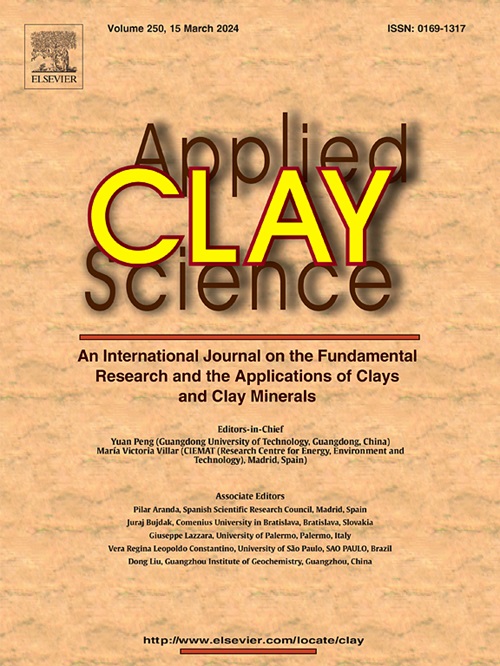Effects of compaction and ionic strength on cation exchange selectivity coefficients of Ca(II), Mg(II), and K(I) for Na(I) in bentonite
IF 5.3
2区 地球科学
Q2 CHEMISTRY, PHYSICAL
引用次数: 0
Abstract
Cation exchange selectivity coefficients of bentonite are crucial for estimating cation compositions of bentonite buffer in the geological disposal of radioactive wastes. For confirming the difference in selectivity coefficients of Ca(II), Mg(II), and K(I) for Na(I) between compacted and dispersed bentonite, column and batch experiments were performed under various ionic strengths. Further, as an applied study, a column experiment was performed using coastal groundwater (ionic strength 0.28 M), and the cation compositions of bentonite after the experiment were numerically simulated using selectivity coefficients for the compacted and dispersed states. The experimental results showed that the selectivity coefficients in the compacted state were higher than those in the dispersed state, and they increased slightly with increasing ionic strength in both states. The numerical simulations agree with the experimental results of cation composition after the column experiment when using the selectivity coefficients determined under the compacted state at the ionic strength of 0.25 M. These results suggest that the selectivity coefficients obtained under the compacted state are preferable for predicting the cation composition of compacted bentonite, especially in saline groundwater environments.
压实度和离子强度对膨润土中Ca(II)、Mg(II)和K(I)对Na(I)阳离子交换选择性系数的影响
在放射性废物地质处置中,膨润土的阳离子交换选择系数是评价膨润土缓冲液阳离子组成的重要依据。为了确定压实膨润土和分散膨润土对Ca(II)、Mg(II)和K(I)的选择性系数的差异,在不同的离子强度下进行了柱状和批状实验。作为应用研究,利用滨海地下水(离子强度0.28 M)进行了柱状实验,并对实验后膨润土在压实和分散状态下的阳离子组成进行了数值模拟。实验结果表明,压实态的选择性系数高于分散态,且随离子强度的增加而略有增加。在离子强度为0.25 m时,采用压实状态下的选择系数对膨润土阳离子组成进行了数值模拟,结果与柱试验后的实验结果一致,表明压实状态下的选择系数对预测压实后的膨润土阳离子组成具有较好的效果,特别是在咸水环境下。
本文章由计算机程序翻译,如有差异,请以英文原文为准。
求助全文
约1分钟内获得全文
求助全文
来源期刊

Applied Clay Science
地学-矿物学
CiteScore
10.30
自引率
10.70%
发文量
289
审稿时长
39 days
期刊介绍:
Applied Clay Science aims to be an international journal attracting high quality scientific papers on clays and clay minerals, including research papers, reviews, and technical notes. The journal covers typical subjects of Fundamental and Applied Clay Science such as:
• Synthesis and purification
• Structural, crystallographic and mineralogical properties of clays and clay minerals
• Thermal properties of clays and clay minerals
• Physico-chemical properties including i) surface and interface properties; ii) thermodynamic properties; iii) mechanical properties
• Interaction with water, with polar and apolar molecules
• Colloidal properties and rheology
• Adsorption, Intercalation, Ionic exchange
• Genesis and deposits of clay minerals
• Geology and geochemistry of clays
• Modification of clays and clay minerals properties by thermal and physical treatments
• Modification by chemical treatments with organic and inorganic molecules(organoclays, pillared clays)
• Modification by biological microorganisms. etc...
 求助内容:
求助内容: 应助结果提醒方式:
应助结果提醒方式:


